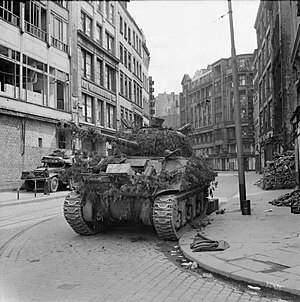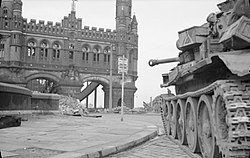Capture of Hamburg
| Capture of Hamburg | |||||||
|---|---|---|---|---|---|---|---|
| Part of the Western Allied invasion of Germany in the Western Front of the European theatre of World War II | |||||||
 A British Sherman Firefly tank in the city centre after the battle. | |||||||
| |||||||
| Belligerents | |||||||
|
|
| ||||||
| Commanders and leaders | |||||||
|
|
| ||||||
| Units involved | |||||||
|
VIII Corps (7th Armoured Division) XII Corps (elements) | 1st Parachute Army (elements) | ||||||
| Strength | |||||||
| 3 Divisions | 2 Divisions (Understrength) | ||||||
| Casualties and losses | |||||||
| Unknown | Unknown | ||||||
The Capture of Hamburg was one of the last battles of World War II, where the remaining troops of the German 1st Parachute Army fought the British XII Corps for the control of Hamburg, Germany between 18 April and 3 May 1945. British troops were met with fierce resistance as Hamburg was the last remaining pocket of resistance in the north. Once the British had captured the city, they continued their advance north-east and sealed off the remnants of the 1st Parachute Army and Army Group Northwest in the Jutland peninsula.
Background[]
After the Western Allies crossed the Rhine River, the German armies in the west began to fall apart. Army Group B, under the command of Walter Model, was the last effective German defence in the west. However the Army Group, consisting of three armies, were encircled and captured by the 1st and 9th American Armies, thus ending effective German resistance in the west.[1] After the defeat of Army Group B, the Germans were only able to organize resistance in a few cities and were not able to communicate with each other very well. The Allied armies started a general advance across Germany, with the Americans pushing the centre and the British holding their northern flank. The main British thrust came from the British Second Army, under the command of Lieutenant General Miles C. Dempsey. The army's objective was to advance across northern Germany and push on to Berlin. The British came across little resistance, compared with the Americans further south, and advanced at a steady and fast pace. The 1st Parachute Army and the newly formed Army Group Northwest were the last German forces in the north. As the British continued their advance, the German high command in Berlin, which was under siege by the Soviet Red Army, refused to send reinforcements. The Germans managed to resist the British in Bremen for a week; the surviving troops retreated to the Jutland peninsula.[2] The last remaining defence was the city of Hamburg and the Germans sought to make a final stand there. After capturing Soltau, the 7th Armoured Division of the VIII Corps was poised to assault the city.
Battle[]
Preliminary moves[]
The British advance towards Hamburg was spearheaded by the 7th Armoured Division, attacking Harburg and advancing to the River Elbe across from Hamburg, with the 15th (Scottish) Infantry Division assaulting the town of Uelzen to the south of the city. Elements of the XII Corps attacked Hamburg itself from the northwest. On their way to Harburg, the 7th Division captured Welle and Tostedt on 18 April and advanced into Hollenstedt the next day. By this time, the Germans had built up defences in Harburg as the British moved closer. On 20 April, the 7th Division captured Daerstorf, 13 km (8 mi) west of the city. The RHA Forward Observation Officers (FOOs), reached the Elbe and began to direct artillery fire upon troops and trains on the other side of the river. On the same day, the British 131st Infantry Brigade took Vahrendorf just two miles south of Harburg.[3] The 7th Division halted the advance for five days just short of Hamburg; it set up a perimeter and prepared for its assault on the city. However, on 26 April, the (12. SS-Verstärkungsregiment), supported by Hitler Youth and assorted Hamburg sailors and policemen, counter-attacked at Vahrendorf. They were supported by 88 mm guns and 75 mm howitzers and reached the town centre, but were pushed back once British tanks arrived. The battle continued until the next day, when the Germans retreated back to Harburg, leaving 60 dead and losing 70 men as prisoners.[4]
Entering the city[]
On 28 April the British began their assault on the city. The 5th Royal Tank Regiment, 9th Durham Light Infantry and 1st Rifle Brigade captured Jesteburg and Hittfeld, where the autobahn was. Nevertheless, the Germans blew up parts of the autobahn at Hittfeld, slowing the British advance.
As the British advanced towards the city, it was clear that the Germans would still not give up. The troops of the 1st Parachute Army were now a mix of a few SS, paratroopers, Volkssturm, along with regular Wehrmacht soldiers, supported by sailors, police, firemen, and Hitler Youth. They were supported by 88 mm guns, which were no longer needed for air defense.
Many German units, including a tank destroyer battalion, a Hungarian SS unit and many Panzerfaust anti-tank troops were also still located in the woods south of Hamburg, as the British had bypassed the area and were now mopping it up. The 53rd (Welsh) Infantry Division, supported by the 1st Royal Tank Regiment assaulted the woods and captured all remaining German troops, a total of 2,000 men.
On 28 April, the 3rd Regiment Royal Horse Artillery began shelling the Phoenix Rubber Works in Hamburg, which brought about a white flag delegation. On 29 April, a deputation from the city came out to discuss surrender. On 1 May, General Alwin Wolz's staff car, under a white flag, approached D Company of the 9th Durham Light Infantry. On 30 April, Adolf Hitler had committed suicide in Berlin and Grand Admiral Karl Dönitz, who was commanding the forces in the north, had ordered Wolz to discuss surrendering the city to the British. Wolz, along with a small German delegation, arrived at Division HQ on 2 May and formally surrendered Hamburg on 3 May. That same afternoon, the 11th Hussars led the 7th Armoured Division into the ruined city.[5][4]

Cromwell tank of 7th Armoured Division, in position by the Neue Elbbrücke in Hamburg, 3 May 1945

Universal carriers of 1/5th Queen's Regiment, 7th Armoured Division in Hamburg

Incomplete German U-boats abandoned at the Blohm and Voss shipyard
Aftermath[]
Hamburg was the last remaining defence for the Germans in the north. After the British had captured the city, the surviving troops of the 1st Parachute Army along with Army Group Northwest retreated into the Jutland Peninsula. Most of them retreated to Kiel, where they met soldiers of Army Group Vistula, who were fleeing from the Soviets on the Eastern Front. The 7th Armoured Division advanced unopposed to Lübeck, where news of the German surrender of northwest Germany came on 4 May, followed by Germany's complete surrender on 8 May.
References[]
- ^ MacDonald, C. (1973). Victory in Europe, 1945: The Last Offensive of World War II. U.S. Government Publishing Office. p. 369.
- ^ Paterson, Ian A. (30 July 2012), Engagements - 1945: Teutoberger, retrieved 17 January 2013.[better source needed]
- ^ "Battles 1945". desertrats.org.uk. Retrieved 9 November 2019.
- ^ a b Paterson, Ian A. (30 July 2012), Engagements - 1945: Hamburg The Final Push to Hamburg, retrieved 17 January 2013
- ^ Ortwin Pelc, Kriegsende in Hamburg, Hamburg 2005
- Land battles of World War II involving the United Kingdom
- Battles of World War II involving Germany
- 1945 in Germany
- 1940s in Hamburg
- April 1945 events
- May 1945 events


